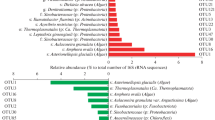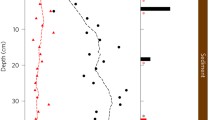Abstract
Methane occurred in the monimolimnion, at depths greater than 11 m, of an antarctic meromictic lake, Ace Lake (depth 24.7 m). Although the water of the lake was of approximate marine salinity, bottom waters were depleted in sulfate (less than 1 mmol 1−1). The temperature of the bottom waters of the lake were constantly between 1 °C and 2 °C. Rates of methanogenesis from 14C-labelled precursors (bicarbonate, formate and acetate) were determined in time course experiments with the detection of 14CH4 produced by a gas chromatography-gas proportional counting system. Rates of 14CH4 production were difficult to determine as the reactions were always near our limit of detection.
Reliable determinations of rates of methanogenesis at some depths using some precursors were obtained, the fastest rate being 2.5 µmol kg−1 day−1 at depth 20 m. Assuming constant rates of methanogenesis with time, this would equate to a turnover of methane in the lake every two years.
The slow rate of methanogenesis suggests that the methanogens in Ace Lake may be working at well below their optimum temperature although definitive statements regarding the presence of psychrophilic methanogens in this antarctic lake must await isolation attempts or longer field studies using alternative methodologies.
Similar content being viewed by others
References
Bayly, I. A. E. & H. R. Burton, 1987. Distribution of Paralapidocera antarctica in Ace Lake. Aust. J. Mar. Freshw. Res. 38: 537–543.
Boon, D. R. & W. B. Whitman, 1988. Proposal of minimal standards for describing new taxa of methanogenic bacteria. Int. J. Syst. Bact. 38: 212–219.
Burton, H. R., 1980. Methane in a saline Antarctic lake. In P. A. Trudinger & M. R. Walter (eds), Biogeochemistry of Ancient and Modern Environments, Australian Academy of Science, Canberra: 243–251.
Burton, H. R., 1981. Chemistry, physics and evolution of Antarctic saline lakes. Hydrobiologia. 82: 339–362.
Burton, H. R. & R. J. Barker, 1979. Sulfur chemistry and microbiological fractionation of sulfur isotopes in a saline Antarctic lake. Geomicrobiol. J. 1: 329–340.
Burton, H. R. & X. Lu-Qiang, In Press. Low molecular weight volatile fatty acids as indicators of bacterial activity in Antarctic marine and hypersaline lake microenvironments. In K. R. Kerry & G. Hempel (eds.). Proceedings from the Scientific Committee on Antarctic Research Fifth Symposium on Antarctic Biology. Spring-Verlag, Heidelberg.
Claypool, G. E. & I. R. Kaplan, 1974. The origin and distribution of methane in marine sediments. In I. R. Kaplan (ed.). Natural gases in marine sediments. Plenum Press, New York. 99–140.
Conrad, R., T. J. Phelps & J. G. Zeikus, 1985. Gas metabolism evidence in support of the juxtaposition of hydrogen-producing and methanogenic bacteria in sewage sludge and lake sediments. Appl. Envir. Microbiol. 50: 595–601.
Conrad, R., Schink, B. & T. J. Phelps, 1986. Thermodynamics of H2-consuming and H2-producing metabolic reactions in diverse methanogenic environments under in situ conditions. FEMS Microbiol. Ecol. 38: 353–360.
Culbertson, C. W., Zehnder, A. J. B. & R. S. Oremland, 1981. Anaerobic oxidation of acetylene by estuarine sediments and enrichment cultures. Appl. Envir. Microbiol. 41: 396–403.
Ellis-Evans, J. C., 1984. Methane in maritime antarctic freshwater lakes. Polar Biol. 3: 63–71.
Ellman, G. L., 1959. Tissue sulphydryl groups. Arch. Biochem. Biophys. 82: 70–74.
Franzmann, P. D., G. W. Skyring, H. R. Burton & P. P. Deprez, 1988. Sulfate reduction rates and some aspects of the limnology of four lakes and a fjord in the Vestfold Hills, Antarctica. In J. M. Ferris, H. R. Burton, G. W. Johnstone & I. A. E. Bayly (eds.), Biology of the Vestfold Hills, Antarctica. Kluwer Academic Publishers, Dordrecht. 25–33.
Hand, R. M., 1980. Bacterial populations of two saline Antarctic lakes. In P. A. Trudinger & M. R. Walter (eds.), Biogeochemistry of Ancient and Modern Environments. Australian Academy of Science, Canberra: 123–129.
Hanselmann, K. W., 1986. Microbially mediated processes in environmental chemistry. Chimia 40: 146–159.
Ivanov, M. W., S. S. Belyaev & K. S. Laurinavichus, 1976. Methods of quantitative investigation of microbiological production and utilization of methane. In H. G. Schlegel, N. Pfennig, G. Gottschank (eds.). Microbial Production and Utilization of gases (H2, CH4, CO) Symp. Proc. Golke-Verlag. Gottingen. 63–67.
Iversen, N., R. S. Oremland & M. J. Klug, 1987. Big Soda Lake (Nevada). 3. Pelagic methanogenesis and anaerobic methane oxidation. Limnol. Oceanogr. 32: 804–814.
Jones, J. G., B. M. Simon & S. Gardner, 1982. Factors affecting methanogenesis and associated anaerobic processes in the sediments of a stratified eutrophic lake. J. Gen. Microbiol. 128: 1–11.
Kiene, R. P., R. S. Oremland, A. Catena, L. G. Miller & D. G. Capone, 1986. Metabolism of reduced methylated sulfur compounds in anaerobic sediments and by a pure culture of an estuarine methanogen. Appl. Envir. Microbiol. 52: 1037–1045.
King, E. W. & D. A. Everitt, 1980. A remote sampling device for under-ice water, bottom biota, and sediments. Limnol. Oceanogr. 25: 935–938.
King, G. M., 1984. Utilization of hydrogen, acetate and ‘noncompetitive’ substrates by methanogenic bacteria in marine sediments. Geomicrobiol. J. 3: 275–305.
King, G. M., M. J. Klug & D. R. Lovely, 1983. Metabolism of acetate, methanol, and methylated amines in intertidal sediments of Lowes Cove, Maine. Appl. Envir. Microbiol. 45: 1848–1853.
Mah, R. A., D. M. Ward, L. Baresi & T. L. Glass, 1977. Biogenesis of methane. Ann. Rev. Microbiol. 31: 309–341.
Martens, C. S. & J. Van Klump, 1980. Biogeochemical cycling in an organic-rich coastal marine basin-I. Methane sediment-water exchange processes. Geochim. Cosmochim. Acta 44: 471–490.
McMeekin, T. A. & P. D. Franzmann, 1988. Effect of temperature on the growth rates of halotolerant and halophilic bacteria isolated from antarctic saline lakes. Polar Biology 8: 281–285.
Nakai, N. & M. L. Jensen, 1964. The kinetic isotope effect in the bacterial reduction and oxidation of sulfur. Geochim. Cosmochim. Acta 28: 1893–1912.
Nelson, D. R. & J. G. Zeikus, 1974. Rapid method for the radioisotopic analysis of gaseous end products of anaerobic metabolism. Appl. Microbiol. 28: 258–261.
Oremland, R. S., L. M. Marsh & S. Polcin, 1982. Methane production and simultaneous sulfate reduction in anoxic, salt marsh sediments. Nature (Lond.) 296: 143–145.
Postgate, J. R., 1951. The reduction of sulfur compounds by Desulfovibrio desulfuricans. J. Gen. Microbiol. 5: 725–738.
Rajagopal, B. S. & L. Daniels, 1986. Investigation of mercaptans, organic sulfides and inorganic sulfur compounds as sulfur sources for the growth of methanogenic bacteria. Current Microbiol. 14: 137–144.
Senior, E., E. B. Lindstrom, I. M. Banat & B. D. Nedwell, 1982. Sulfate reduction and methanogenesis in the sediment of saltmarsh on the east coast of the United Kingdom. Appl. Envir. Microbiol. 43: 987–996.
Skyring, G. W., L. A. Chambers & J. Bauld, 1983. Sulfate reduction in sediments colonised by cyanobacteria, Spencer Gulf, South Australia. Aust. J. Mar. Freshw. Res. 34: 359–374.
Smith, R. L. & M. J. Klug, 1987. Flowthrough reactor flasks for study of microbial metabolism in sediments. Appl. Envir. Microbiol. 53: 371–374.
Sorensen, J., D. Christensen & B. B. Jorgensen, 1981. Volatile fatty acids and hydrogen as substrates for sulfate-reducing bacteria in anaerobic marine sediments. Appl. Envir. Microbiol. 42: 5–11.
Strickland, J. D. H. & T. R. Parsons, 1972. A Practical Handbook of Seawater Analysis. 2nd. Edition. Bull. Fish. Res. Bd Can. 167: 310.
Tabatabai, M. A., 1974. Determination of sulfate in water samples. Sulfphur Inst. J. 10: 11–12.
Volkman, J. K., H. R. Burton, D. A. Everitt & D. I. Allen, 1988. Pigment and lipid composition of algal and bacterial communities in Ace Lake, Vestfold Hills, Antarctica. In J. M. Ferris, H. R. Burton, G. W. Johnstone & I. A. Bayly (eds.), Biology of the Vestfold Hills, Antarctica. Kluwer Academic Publishers, Dordrecht. 41–58.
Winfrey, M. R., D. R. Nelson, S. C. Klevickis & J. G. Zeikus, 1977. Association of hydrogen metabolism with methanogenesis in Lake Mendota sediments. Appl. Envir. Microbiol. 33: 312–318.
Winfrey, M. R. & J. G. Zeikus, 1977. Effect of sulfate on carbon and electron flow during microbial methanogenesis in freshwater sediments. Appl. Envir. Microbiol. 33: 275–281.
Winfrey, M. R. & J. G. Zeikus, 1979. Microbial methanogenesis and acetate metabolism in a meromictic lake. Appl. Envir. Microbiol. 37: 213–221.
Yusa, Y., 1979. Analysis of thermosolutal phenomena observed in McMurdo saline lakes (Extended Abstract). In T. Nagata (ed.), Proceedings of the Seminar III on Dry Valley Drilling Project, 1978. Memoirs of National Institute of Polar Research Special Issue No. 13. Tokyo: 42–48.
Zehnder, A. J. B. & T. D. Brock, 1980. Anaerobic methane oxidation: occurrence and ecology. Appl. Envir. Microbiol. 39: 194–204.
Zeikus, J. G. & M. R. Winfrey, 1976. Temperature limitation of methanogenesis in aquatic sediments. Appl. Envir. Microbiol. 31: 99–107.
Zimmermann, R., 1977. Estimation of bacterial number and biomass by epifluorescence microscopy and scanning electron microscopy. In G. Reinheimer (ed.), Microbial Ecology of a Brackish Water Environment. Springer Verlag, Heidelberg: 103–120.
Zinder, S. H. & M. Koch, 1984. Non-aceticlastic methanogenesis from acetate: acetate oxidation by thermophilic syntrophic coculture. Arch. Microbiol. 138: 263–272.
Author information
Authors and Affiliations
Rights and permissions
About this article
Cite this article
Franzmann, P.D., Roberts, N.J., Mancuso, C.A. et al. Methane production in meromictic Ace Lake, Antarctica. Hydrobiologia 210, 191–201 (1991). https://doi.org/10.1007/BF00034677
Received:
Revised:
Accepted:
Issue Date:
DOI: https://doi.org/10.1007/BF00034677




